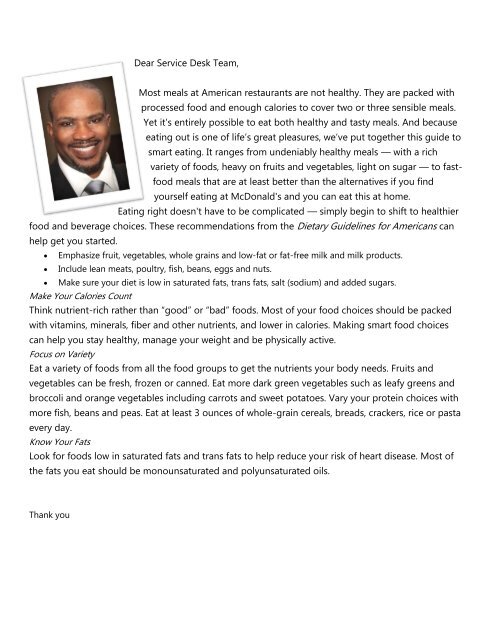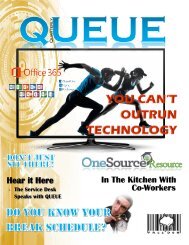QUEUE Spring Vol 2
Create successful ePaper yourself
Turn your PDF publications into a flip-book with our unique Google optimized e-Paper software.
Dear Service Desk Team,<br />
Most meals at American restaurants are not healthy. They are packed with<br />
processed food and enough calories to cover two or three sensible meals.<br />
Yet it’s entirely possible to eat both healthy and tasty meals. And because<br />
eating out is one of life’s great pleasures, we’ve put together this guide to<br />
smart eating. It ranges from undeniably healthy meals — with a rich<br />
variety of foods, heavy on fruits and vegetables, light on sugar — to fastfood<br />
meals that are at least better than the alternatives if you find<br />
yourself eating at McDonald's and you can eat this at home.<br />
Eating right doesn't have to be complicated — simply begin to shift to healthier<br />
food and beverage choices. These recommendations from the Dietary Guidelines for Americans can<br />
help get you started.<br />
Emphasize fruit, vegetables, whole grains and low-fat or fat-free milk and milk products.<br />
Include lean meats, poultry, fish, beans, eggs and nuts.<br />
Make sure your diet is low in saturated fats, trans fats, salt (sodium) and added sugars.<br />
Make Your Calories Count<br />
Think nutrient-rich rather than “good” or “bad” foods. Most of your food choices should be packed<br />
with vitamins, minerals, fiber and other nutrients, and lower in calories. Making smart food choices<br />
can help you stay healthy, manage your weight and be physically active.<br />
Focus on Variety<br />
Eat a variety of foods from all the food groups to get the nutrients your body needs. Fruits and<br />
vegetables can be fresh, frozen or canned. Eat more dark green vegetables such as leafy greens and<br />
broccoli and orange vegetables including carrots and sweet potatoes. Vary your protein choices with<br />
more fish, beans and peas. Eat at least 3 ounces of whole-grain cereals, breads, crackers, rice or pasta<br />
every day.<br />
Know Your Fats<br />
Look for foods low in saturated fats and trans fats to help reduce your risk of heart disease. Most of<br />
the fats you eat should be monounsaturated and polyunsaturated oils.<br />
Thank you




